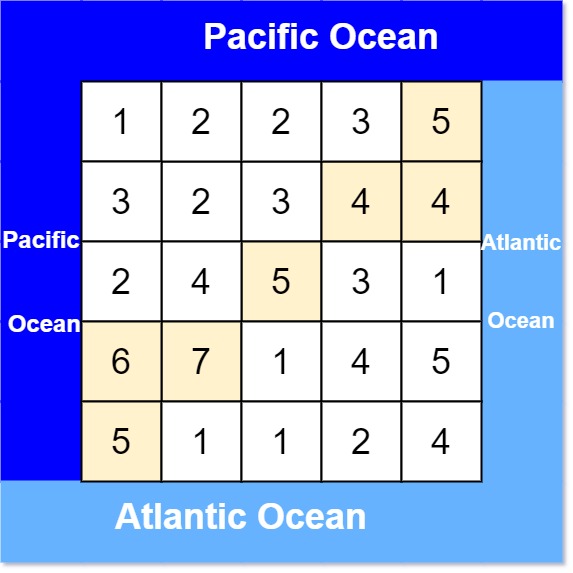LeetCode-417. Pacific Atlantic Water Flow
難度: medium
There is an m x n rectangular island that borders both the Pacific Ocean and Atlantic Ocean . The Pacific Ocean touches the island’s left and top edges, and the Atlantic Ocean touches the island’s right and bottom edges. The island is partitioned into a grid of square cells. You are given an m x n integer matrix heights where heights[r][c] represents the height above sea level of the cell at coordinate (r, c). The island receives a lot of rain, and the rain water can flow to neighboring cells directly north, south, east, and west if the neighboring cell’s height is less than or equal to the current cell’s height. Water can flow from any cell adjacent to an ocean into the ocean. Return a 2D list of grid coordinates result where result[i] = [ri, ci] denotes that rain water can flow from cell (ri, ci) to both the Pacific and Atlantic oceans.
Example 1:

Input: heights = [[1,2,2,3,5],[3,2,3,4,4],[2,4,5,3,1],[6,7,1,4,5],[5,1,1,2,4]]
Output: [[0,4],[1,3],[1,4],[2,2],[3,0],[3,1],[4,0]]
Explanation: The following cells can flow to the Pacific and Atlantic oceans, as shown below:
[0,4]: [0,4] -> Pacific Ocean
[0,4] -> Atlantic Ocean
[1,3]: [1,3] -> [0,3] -> Pacific Ocean
[1,3] -> [1,4] -> Atlantic Ocean
[1,4]: [1,4] -> [1,3] -> [0,3] -> Pacific Ocean
[1,4] -> Atlantic Ocean
[2,2]: [2,2] -> [1,2] -> [0,2] -> Pacific Ocean
[2,2] -> [2,3] -> [2,4] -> Atlantic Ocean
[3,0]: [3,0] -> Pacific Ocean
[3,0] -> [4,0] -> Atlantic Ocean
[3,1]: [3,1] -> [3,0] -> Pacific Ocean
[3,1] -> [4,1] -> Atlantic Ocean
[4,0]: [4,0] -> Pacific Ocean
[4,0] -> Atlantic Ocean
Note that there are other possible paths for these cells to flow to the Pacific and Atlantic oceans.
Example 2:
Input: heights = [[1]]
Output: [[0,0]]
Explanation: The water can flow from the only cell to the Pacific and Atlantic oceans.
Constraints:
m == heights.length.n == heights[r].length1 <= m, n <= 2000 <= heights[r][c] <= 105
Follow up: A linked list can be reversed either iteratively or recursively. Could you implement both?
解題流程
- 先看懂題目想描述甚麼情境
- 開始想像程式運作該經過哪些流程
- 將經過的流程所需的判斷跟細節列出
- 實作列出的流程
先看懂題目想描述甚麼情境
開始想像程式運作該經過哪些流程
將經過的流程所需的判斷跟細節列出
實作列出的流程
typescript
function pacificAtlantic(heights: number[][]): number[][] {
const rows = heights.length;
const cols = heights[0].length
const toPacific = new Array(rows).fill(false).map(() => new Array(cols).fill(false));
const toAtlantic = new Array(rows).fill(false).map(() => new Array(cols).fill(false));
const result = [];
const markCanFlowToOcean = ([pointY,pointX]: number[], ocean: boolean[][]) => {
ocean[pointY][pointX] = true;
const nextSteps = [[pointY - 1, pointX], [pointY + 1, pointX], [pointY, pointX + 1], [pointY, pointX - 1]];
nextSteps.forEach(([nextPointY, nextPointX])=> {
if(
nextPointX >= 0 &&
nextPointY >= 0 &&
nextPointX < ocean[0].length &&
nextPointY < ocean.length &&
!ocean[nextPointY][nextPointX]
) {
if(heights[nextPointY][nextPointX] >= heights[pointY][pointX]){
markCanFlowToOcean([nextPointY,nextPointX], ocean);
}
}
})
}
for(let i = 0; i < rows; i++) {
markCanFlowToOcean([i,0],toPacific);
markCanFlowToOcean([i,cols - 1],toAtlantic);
}
for(let i = 0; i < cols; i++) {
markCanFlowToOcean([0, i],toPacific);
markCanFlowToOcean([rows - 1, i],toAtlantic);
}
for(let i = 0; i < rows; i++) {
for(let j = 0; j < cols; j++) {
if(toPacific[i][j] && toAtlantic[i][j]) {
result.push([i,j]);
}
}
}
return result;
};感謝閱讀,如果有錯誤或是講得不清楚的部分,再請留言指教